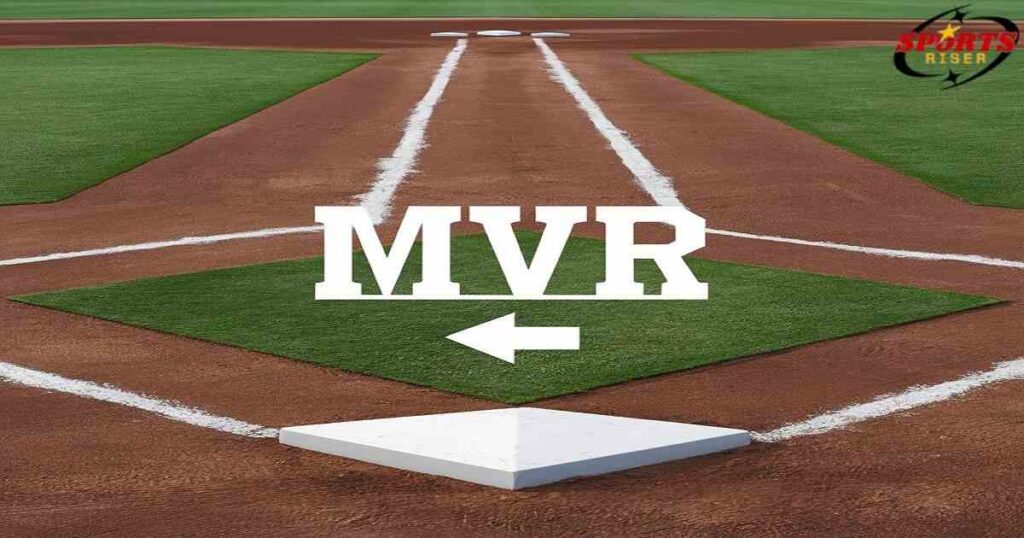Baseball is a game of strategy, precision, and rules that shape how teams play and manage their resources. One such rule that has significantly impacted modern baseball is MVR (Mound Visits Remaining). Understanding what MVR in baseball means is crucial for fans, players, and analysts alike, as it influences a team’s pitching strategy and overall gameplay.
In this comprehensive guide, we will break down what MVR stands for in baseball, how it works, why it was introduced, and its implications on Major League Baseball (MLB) teams.
Understanding MVR in Baseball
Mound Visits Remaining (MVR) is a metric introduced by Major League Baseball (MLB) to regulate the number of times a coach, catcher, or position player can visit the pitcher during a game. The rule was implemented in 2018 to improve the pace of play, ensuring games do not drag due to excessive mound discussions.
MVR is prominently displayed on the scoreboard display during professional baseball games, allowing teams and fans to track the number of remaining mound visits.
What Does MVR Stand For?
What does MVR stand for in baseball? Simply put, MVR means Mound Visits Remaining. It tracks how many mound visits a team has left before facing potential penalties. These visits allow managers, coaches, or catchers to communicate with the pitcher about game tactics, defensive positioning, or other concerns.
Key Features of MVR:
- Applies to all teams in Major League Baseball (MLB) and National Collegiate Athletic Association (NCAA) games.
- Displayed on scoreboards to help teams monitor their remaining visits.
- Restricted to a fixed number of visits per game to enhance game flow.
How Mound Visits Impact the Game

Mound visits play a critical role in a team’s pitching strategy. These visits can help:
- Fix a cross-up in signals between the pitcher and catcher.
- Discuss defensive positioning based on the batter’s tendencies.
- Address pitching mechanics issues before they escalate.
- Give the relief pitcher more time to warm up.
However, with the introduction of MVR limits, teams must be strategic in using their visits wisely.
MLB’s Mound Visit Rules Explained
According to MLB rules, each team is allowed five mound visits per nine-inning game. These visits include any trip to the pitcher’s mound by the manager, coach, catcher, or position player.
Exceptions to the Mound Visit Rule:
- Pitching changes do not count toward the mound visit limit.
- Injury concerns allow an extra visit, as determined by an umpire decision.
- If a cross-up in signals occurs, a visit is allowed without being counted.
- The extra innings rule grants teams one additional mound visit for each extra inning.
Consequences of Exceeding the MVR Limit:
If a team runs out of mound visits, the umpire may restrict further visits unless a pitching change occurs or there is an injury concern.
What Happens When a Team Runs Out of MVR?
What happens when a team runs out of MVR? If a team has used all its mound visits, the catcher and infielders are prohibited from visiting the mound unless:
- A relief pitcher is being substituted.
- The umpire allows an exception due to an injury or signal clarification visit.
- There is a game suspension, requiring a restart of mound visit allowances.
Why Did MLB Limit Mound Visits?
The main reason MLB limited mound visits was to speed up the game and improve the pace of play. Before the rule change, excessive mound visits slowed down gameplay, making it less engaging for fans.
Key Reasons for Limiting Mound Visits:
- Game duration – The rule helps reduce unnecessary delays.
- Fan engagement – Faster games maintain viewer interest.
- Pitching strategy evolution – Teams must adapt and plan visits wisely.
- Television ratings – Shorter games are more appealing for broadcasting.
Also Read : Lovie Smith: Bio, Age, Coaching Journey, Net Worth, and More
Is MVR Shown on the Scoreboard?

Yes! MVR is prominently displayed on the scoreboard display in MLB stadiums. This allows teams and fans to track how many mound visits remain. Broadcasters also highlight MVR stats in baseball during live games.
Mound Visits vs. Bullpen Visits: What’s the Difference?
Many fans wonder, what’s MVR in baseball and how it differs from bullpen visits. The key differences are:
| Feature | Mound Visit | Bullpen Visit |
|---|---|---|
| Purpose | Discussing strategy, correcting signals | Preparing a relief pitcher |
| Who Initiates? | Manager, catcher, or position player | Manager or pitching coach |
| MVR Limitation | Yes – Limited per game | No – Unlimited |
| Where It Happens | Pitcher’s mound | Bullpen area |
Final Thoughts: How MVR Affects Baseball Strategy
MVR in baseball has dramatically changed how managers and players approach the game. The introduction of mound visit limits means teams must think ahead and plan each visit carefully. The rule has led to:
- More efficient communication between pitchers and catchers.
- Better game management by coaches and managers.
- Increased reliance on signals and defensive positioning to avoid unnecessary visits.
Ultimately, understanding what MVR in baseball means is essential for appreciating the strategic depth of the game. Whether you’re a casual fan or a seasoned analyst, knowing how MVR stats in baseball shape match outcomes can enhance your viewing experience.
With MLB’s mound visit rules, baseball continues to evolve, blending tradition with modern efficiency. The next time you watch a game, keep an eye on the scoreboard display to track each team’s MVR and see how it influences their pitching strategy!

Joi Biden is a seasoned blogger with a passion for uncovering the dynamic world of sports. With years of experience in crafting engaging and insightful content, Joi brings a unique perspective to Sports Riser. His writing blends in depth analysis with captivating storytelling, keeping readers informed and entertained. When he’s not writing, Joi enjoys exploring emerging sports trends and cheering for his favorite teams.










